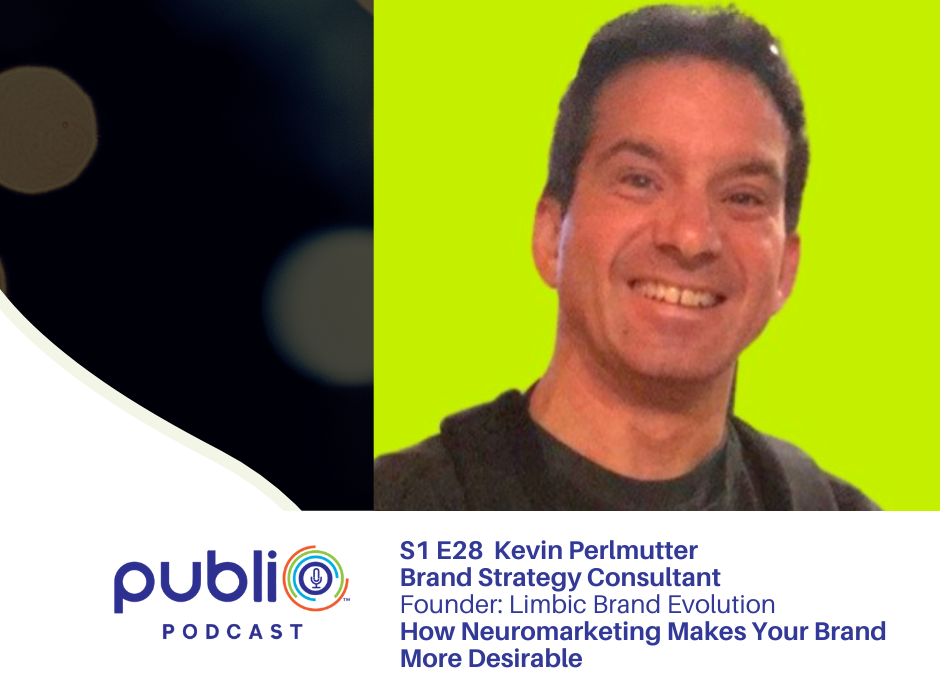Neuromarketing influences how your customers feel about your brand. This term is new to brand strategy, but the concept has been used for centuries. The way we use neuromarketing has changed dramatically in recent years.
A neuromarketing brand strategy gets to the heart of what people care about, and leads to immediately actionable results.
“Before the internet and social media, people relied on advertising to understand what a brand was all about,” said Kevin Perlmutter, chief strategist and founder of Limbic Brand Evolution.
In the pre-Internet days, a consumer’s attitude about a brand could be influenced by their friends, but because the number of news and information outlets was small, brand managers enjoyed an outsized advantage in shaping how consumers thought about their companies.
As a result, brand strategy started to change in the mid-1990s.
“Brands woke up to the fact that online reviews, social media, and the massive amount of content that people could share about their experience with a brand was starting to influence consumers on a mass scale,” Perlmutter told Publio CEO Keith Reynolds in this episode of the Publio Podcast.
This new level of influence has huge implications on brand strategy because now we have so many ways to interact directly with customers – whether your business is focused on B2B or B2C or B2B2C. People actually experience your brand online; not just see or hear it in advertising. They develop real feelings through their experiences.
Limbic Sparks from Neuromarketing Drive Brand Strategy
What is the impact on your brand strategy? Internal notions about how you feel about a brand originates in the limbic part of the human brain.
“This is the non-conscious part of our brain that supports emotion, motivation, behavior, and memory,” Perlmutter explained. “My work is all around creating what I call ‘limbic sparks,’ which happen when emotional motivation meets brand desire. It’s all around understanding the emotional insights on how a brand can create stronger connections with the people they’re trying to reach.”
Perlmutter helps brand owners set a strategic foundation for all of their marketing customer experiences, and how they convey what their product or service is all about. He is a strategic advisor to the brand and marketing leaders of these companies, and he helps them create stronger connections with the people they’re trying to reach.
Three Neuromarketing Concepts: Focus, Connect, Evolve
Brand owners’ biggest challenge is that they’re not focused on their customers’ needs and desires. When that happens, Perlmutter said, you end up talking about what you do, and less about why people should care.
“You end up talking past people,” he emphasized. Perlmutter’s three-pronged approach helps his clients shift their messages.
Focus
Begin with the client, and zero in on understanding what makes a brand tick from their point of view:
- What does the company do that makes their customers’ lives better?
- What motivates and drives the company’s employees every day?
- What are the things that are really important to them and, and why should customers care?
- How do we get these facts in front of customers in a more compelling way?
Connect
Do the company’s motivations and desires match those of the people they’re trying to reach?
“People aren’t in the world just wandering around looking for brands and products and services to buy and fill their lives with,” Perlmutter said. “They’re trying to run a business. They’re trying to have a good life. They’re trying to be more successful. They’re trying to be happy.They’re trying to overcome challenges and stresses, and they’re not thinking about your brand.
Your brand is made of messages and experiences. These must align with what makes your customers tick in order for it to express itself in a relevant way. Perlmutter calls this the limbic sparks approach to brand strategy.
“Limbic sparks happen when emotional motivation meets brand desire. It’s that intersection of emotional motivation between a brand and the audience that it’s trying to reach.” Perlmutter noted.
Evolve
Focus and connect represent Permutter’s foundational work. The final, critical step is to apply the new strategy to the client’s brand communications – the sales channels, content development, the various ways they talk about their products and services.
Every message that the company and its employees use must come from that foundational strategy that will create the limbic sparks.
Neuromarketing Case Study: AT&T Performing Arts Center
The AT&T Performing Arts Center is well-known and respected by wealthy people in Dallas because of their amazing buildings and incredible performances. But information about their work with non-profit organizations got lost.
Few people knew about how the performing arts helped underprivileged children access the performing arts in terms of viewership, and education. Or how they help emerging artists gain access to stages. Or how they help families with opportunities to view performances and participate in activities such as festivals or yoga in the park.
Perlmutter’s Focus, Connect, Evolve model uncovered the fact that their tagline – AT&T Performing Art Center: Staging the Amazing – was all about them. It led them to talk about how amazing they are. While that was certainly true, the message did not connect to the people they were trying to reach.
Perlmutter’s process uncovered the fact that when people entered the center’s spaces, they discovered that they could actually belong there. And yet, so many people in Dallas had yet to experience this.
“We knew it was a brand for them, they just didn’t feel it yet,” Permutter recalled. “We changed the tagline to ‘AT&T Performing Art Center: Yours to Discover.’”
Perlmutter’s team brought the Yours to Discover language into all of the performing arts center’s marketing communications and shifted the messaging to all the things that people could discover when they came to a performance.
The shift inspired discovery and helped people recognize what an amazing place the AT&T Performing Arts Center is, which, ironically, is a payoff for their original tagline.
The difference is, the customers are saying that the AT&T Performing Arts Center is amazing – and they believe it.
Contact Kevin Perlmutter
Website: LimbicBrandEvolution.com
Podcast: Let’s Talk Limbic Sparks
Blog: Emotional Intelligence
LinkedIn: Linkedin.com/in/KevinPerlmutter
A Fractional CCMO for Your Company
As a Fractional CCMO (Chief Content Marketing Officer), Publio specializes in helping clients firm differentiate their offerings and create content that stands apart from their competitors. We use today’s cloud and AI technologies to deploy targeted media, generate new business and provide an excellent customer experience. We guide clients through our signature Publisher’s M.O.™ methodology to design and implement a content marketing strategy and plan that leads to sustainable results and ROI.
Publio brings a data-driven perspective to technology, finance, and professional services firms to open doors, qualify leads and get sales appointments.
Curious to learn how Publio can help your business? Schedule a free consultation with us today!
Listen to the Publio Podcast
Jump in on the conversations and some serious real talk with executives and thought leaders on growing your business with digital media.Find us on Spotify, and follow your North Star.
We discuss innovation, marketing, business, events, books, successful must-see strategies, and anything that is positive and refreshing.
If you are responsible for your company’s success, pull up a chair, grab some coffee, tune in and connect with your customer audience.

